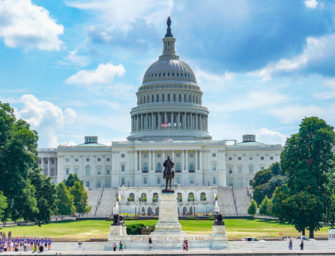Proposed Agency Cuts Threaten Critical Lines of Defense for Public Safety, Economy and Security
Last week, advance details of the White House’s proposed cuts to NOAA and the EPA were published by the Washington Post. NOAA’s overall budget is proposed to be cut by a total of 17%, with some programs slated to be cut more deeply or eliminated altogether. The White House proposal would cut the EPA budget by 25%, where 20% of staff would also be cut. These numbers are preliminary – the official release of the first White House budget proposal is expected to come mid-March – and Congress will have the final say over each agency’s budget. Nonetheless, it is discouraging to see a White House proposal with funding levels that would devastate our ability to safeguard national security, protect public health, and secure the livelihood of communities around the nation. Proposals for the other science agencies, including USGS, DOE, NASA, and others, haven’t been released yet, but all indicators point to similar cuts that could destabilize and undermine crucial research and science programs. We will update this blog post as additional information is made available.
These seemingly subjective cuts ignore the fact that these science-based programs work in tandem with one another. Our environment, climate and oceans are complex, symbiotic systems that work together in dynamic ways that we are only beginning fully understand. Cutting funding to one program reduces our effectiveness in managing of all of them. In addition, the cuts to these agencies will have trickle down effects on diverse U.S. industries – from shipping to transportation, defense to aerospace which rely daily upon the data they produce.
The impact of the proposed cuts we have learned of thus far is clear when you consider how we rely on NOAA and EPA science:
Over a third of the U.S. economy – $3 trillion annually – is influenced by and depends upon the most accurate climate, weather, and natural hazard data, which makes Earth observations like those done by NOAA vital to our society. Weather- and climate-sensitive industries such as agriculture, insurance, real estate, and manufacturing account for up to 40% of the U.S. economy annually. The agriculture industry alone sees $460 million in annual savings from accurate El Nino and La Nina forecasting, which come from NOAA’s satellites and monitoring programs. In 2003, the National Research Council estimated that the socioeconomic value of Earth observations, such as those performed by NOAA, is about $1 trillion annually. Cutting programs that farms, small businesses and Fortune 500 companies alike rely on, and which yield such high returns on investment, at best seems short-sighted.
Equally short-sighted are the cuts to programs that protect the safety and financial security of American families. Without the NOAA programs designed to protect the U.S. coastal shoreline from degradation and extreme weather events, the 39 percent of our population that lives in coastal areas will be at risk. The scientific research and resources developed at NOAA related to weather forecasting also allows communities to receive notice of the accurate storm trajectories, giving them time to evacuate and reducing the extent of loss. And drought forecasts, which are also under threat, protect millions of businesses and lives every year. Cutting funding to these programs would cost more in unintended impacts than they could ever save.
While much of their work is regulatory – something that AGU, as a scientific society, does not take a position on – the EPA’s credible, accurate and peer-reviewed science “provides the foundation for Agency policies, actions, and decisions made on behalf of the American people.” According to the EPA website, “EPA’s clean air research has provided the basis for National Ambient Air Quality Standards that have helped increase life expectancy. EPA scientists are ushering in a new paradigm of faster, far less expensive chemical testing and screening tools and techniques. These efforts will provide critical insight into the pathways that link chemical exposure and potential health effects. EPA scientists are working with decision makers and local communities across the nation to provide the tools, knowledge, and other solutions they need to protect clean, adequate, and equitable water supplies and resources.” This makes EPA science critical to protecting all Americans “from significant risks to human health and the environment where they live, learn and work.”
Fortunately, these reported budget proposals for NOAA and EPA are preliminary. Agency heads may resist some of the cuts, and there will be many discussions and deliberations and likely alternative proposals developed. The same will be true of the other agencies when their budget proposals are released. Ultimately it is the congressional appropriations process that will actually set the funding levels for the federal science agencies. We in the Earth and space science community have an opportunity and an obligation to help inform and influence that process.
AGU will be working diligently over the coming weeks and months to communicate the value of Earth and space science to both Congress and the Administration. We will work to make the case about just how damaging these far-reaching cuts would be if they were to be implemented. But we can’t be the only voice in this effort.
Get involved by visiting our Policy Action Center and writing to your members of Congress to tell them how critical programs at NOAA, EPA and other science agencies are to our safety, health, and economy. These programs have profound impacts on local communities and economies, and congressional representatives need to hear that from people in their own districts. Consider writing to your local newspaper to help ensure that your local businesses and neighbors know what is at stake. Ask your local business leaders and colleagues to do the same.
It’s only by working together that we will be able to preserve federal science funding levels that are essential to securing the safety of the public and the health of the environment and economy.



For the most part I support the cuts!